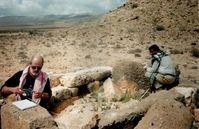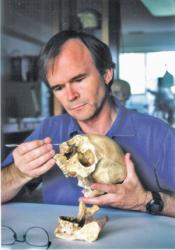- 06 MAI
- SUISSE - Baar --Une peinture murale sur bois du Moyen-Age a été découverte dans une ferme à Baar (ZG). Cette découverte exceptionnelle a été datée d’environ 1530, a annoncé jeudi le Service archéologique et de la protection des monuments du canton de Zoug. Sur une longueur de plusieurs mètres, elle représente un porte-drapeaux, une scène de crucifixion et des saints-- La peinture murale a été découverte lors de travaux de démolition d’une ferme construite à Baar en 1665. En examinant de près le bâtiment, les archéologues ont découvert qu’une moitié du bâtiment était beaucoup plus ancienne. Il a fallu une grue pour évacuer la paroi en vue de la confier aux archéologues, pour restauration. La peinture était en effet recouverte d’une bonne couche de suie. Le bois utilisé date de 1420: c’est ce que montre l’analyse effectuée par dendrochronologie, par l’étude des cernes. Après restauration, on reconnaît Marie, Jésus et Joseph, ainsi que trois groupes de personnages en face. On reconnaît notamment St-Martin, qui avait coupé son manteau pour vêtir un mendiant, et St-Elegius, le saint patron des forgerons. Cette peinture représente un témoignage inestimable d’une maison d’habitation de Suisse centrale de la fin du Moyen-Age, se sont félicités les spécialistes.
http://www.tdg.ch/peinture-murale-1530-decouverte-fortuitement-ferme-zougoise-2011-05-05
- INDE – Jagathipadu - Recent excavations conducted at Jagathipadu village in Polaki mandal of Srikakulam district by the archaeology department brought to light remains of a brick stupa that dates back to the 1st century BC. The stupa is located on the left bank of the river Vamsadhara and is opposite to the famous Buddhist site -- Salihundam. The excavations laid bare huge quantities of red ware (pottery of various types and sizes) and terracotta tiles used to cover the roof of the viharas (dwellings) and other structures, and a few terracotta beads. Archaeology and museums director P Chenna Reddy said on Thursday, "We inspected the site and thoroughly examined the archaeological operations and observed that the stupa was raised on a terraced platform, a special feature noticed in north coastal Andhra only. The bricks measured 60x30x7 cm and mud was used as binding material."
http://articles.timesofindia.indiatimes.com/2011-05-06/hyderabad/29516119_1_buddhist-site-buddhist-stupa-excavations
- AZERBAIDJAN –  Sheki-Gakh-Oguz - In mid-May, the Azerbaijani National Academy of Sciences’ Institute of Archaeology and Ethnography will begin archaeological excavations in eight ancient settlements discovered in the Sheki-Gakh-Oguz region. As a result of research carried out in October-January in the winter pastures in the Sheki-Zagatala-Gakh region, eight ancient settlements dating back to the Bronze Age were found, head of the Sheki-Gakh-Oguz Expedition of the Institute Nasib Mukhtarov told Trend. The area of these settlements is 50-60 hectares, he said. Four are located in Gakh, one - in the winter pastures of Zagatala region, the other three settlements in the territory of Sheki region. One settlement in Sheki is located 5-6 kilometers from the city, the other two settlements are located in the river valley. He said that archaeological work will continue until July.
Sheki-Gakh-Oguz - In mid-May, the Azerbaijani National Academy of Sciences’ Institute of Archaeology and Ethnography will begin archaeological excavations in eight ancient settlements discovered in the Sheki-Gakh-Oguz region. As a result of research carried out in October-January in the winter pastures in the Sheki-Zagatala-Gakh region, eight ancient settlements dating back to the Bronze Age were found, head of the Sheki-Gakh-Oguz Expedition of the Institute Nasib Mukhtarov told Trend. The area of these settlements is 50-60 hectares, he said. Four are located in Gakh, one - in the winter pastures of Zagatala region, the other three settlements in the territory of Sheki region. One settlement in Sheki is located 5-6 kilometers from the city, the other two settlements are located in the river valley. He said that archaeological work will continue until July.
http://en.trend.az/news/society/1871910.html
- USA – Bentonville - Grave markers honoring 20 Confederate soldiers who died during the three-day Battle of Bentonville, which caused nearly 4,200 Union and Confederate casualties, will be dedicated at the site on June 11. The farm home of John and Amy Harper became the Union Army XIV field hospital during the battle, where nearly 600 Union soldiers and an unknown number of Confederates were treated. After the battle the Union army marched on to Goldsboro, paroling at least 45 wounded Confederates left in the care of the Harpers. In spite of the Harpers’ best efforts, 23 of the soldiers died and 20 were buried on the farm (March 1865). Over the years the exact location of the Confederate graves was lost. Thanks to 21st-century technology and discovery of a late 19th-century photograph, the cemetery was found. The picture shows 20 headstones and footstones just south of the Harper family cemetery. Assistant State Archaeologist John Mintz and Wake Forest University Director of Public Archaeology Kenneth Robinson led a team of archaeologists who confirmed the graves’ location using ground-penetrating radar.
http://www.theapexherald.com/view/full_story/13147370/article-Confederate-cemetery-to-be-dedicated-at-Bentonville?instance=home_news_lead
- CANADA – Chatham - The gravestones and markers of some of Chatham's early black residents will be restored over the next two months. Among the tombstones is one marking the final resting place of Henry and Annie Weaver. The Weavers were both slaves who escaped to Canada and settled in Chatham. They became one of Chatham's most affluent families, with Henry becoming a grand master in the Masonic Lodge and the first black municipal councillor in the City of Chatham in the 1890s. Chatham-Kent was an extremely important settlement point for free blacks and refugees from slavery in the mid-1800s and became a Mecca for education, business, religion, literature, and political activism that had a direct impact on the future of North America
http://www.torontosun.com/2011/05/06/grave-markers-of-early-black-residents-to-be-restored
- USA –  Idaho - Kennewick Man, a skeleton found in 1996 by the Army Corps of Engineers in Washington and studied by physical anthropologist Jim Chatters, is one of the two best early male skeletons that archaeologists have from the Americas. Combining evidence from the more-than-9,000-year-old skeleton with other archaeological information, scientists have come up with a surprising theory. “You have people who look like Kennewick Man, and then people who look like modern Indians, and there’s a very rapid switch. … That strongly indicates that we’re dealing with what in scientific terms is called ethnic replacement, people of one biological group replacing another,” said Chatters, This switch could be evolutionary, or it could mean a new group of people came in and replaced the people Kennewick Man would have recognized. Chatters noted that remains of ancient women in the Pacific Northwest consistently show they had poor nutrition and short lives, while the ancient men are consistently found with serious injuries, many sustained over the course of their lifetimes. “Most of the mining that was done in Idaho was called flower gold, a very fine powdery gold, used primarily to save up into ingots,” said Margaret Stallknecht, who will present “The story of rock through time” in several locations across the state, including Mountain Home Air Force Base on Monday. The miners would place this flower gold with mercury in a potato, and then bake it, opening the potato to find the gold in a more usable form. Unfortunately, many found something else when the potato was opened: “A lot of the miners died from mercury inhalations.”Stallknecht, education coordinator for the Idaho Museum of Mining and Geology, will also show off rock artifacts like mortars and pestles — small ones were used to grind hallucinatory peyote for ceremonies, she said — and arrowheads. The audience will get to handle artifacts that were used by a range of people, from the ancient to the pioneer-
Idaho - Kennewick Man, a skeleton found in 1996 by the Army Corps of Engineers in Washington and studied by physical anthropologist Jim Chatters, is one of the two best early male skeletons that archaeologists have from the Americas. Combining evidence from the more-than-9,000-year-old skeleton with other archaeological information, scientists have come up with a surprising theory. “You have people who look like Kennewick Man, and then people who look like modern Indians, and there’s a very rapid switch. … That strongly indicates that we’re dealing with what in scientific terms is called ethnic replacement, people of one biological group replacing another,” said Chatters, This switch could be evolutionary, or it could mean a new group of people came in and replaced the people Kennewick Man would have recognized. Chatters noted that remains of ancient women in the Pacific Northwest consistently show they had poor nutrition and short lives, while the ancient men are consistently found with serious injuries, many sustained over the course of their lifetimes. “Most of the mining that was done in Idaho was called flower gold, a very fine powdery gold, used primarily to save up into ingots,” said Margaret Stallknecht, who will present “The story of rock through time” in several locations across the state, including Mountain Home Air Force Base on Monday. The miners would place this flower gold with mercury in a potato, and then bake it, opening the potato to find the gold in a more usable form. Unfortunately, many found something else when the potato was opened: “A lot of the miners died from mercury inhalations.”Stallknecht, education coordinator for the Idaho Museum of Mining and Geology, will also show off rock artifacts like mortars and pestles — small ones were used to grind hallucinatory peyote for ceremonies, she said — and arrowheads. The audience will get to handle artifacts that were used by a range of people, from the ancient to the pioneer-
http://www.magicvalley.com/entertainment/events/article_2dbdacd0-e45e-509e-81bc-8270ea51af67.html